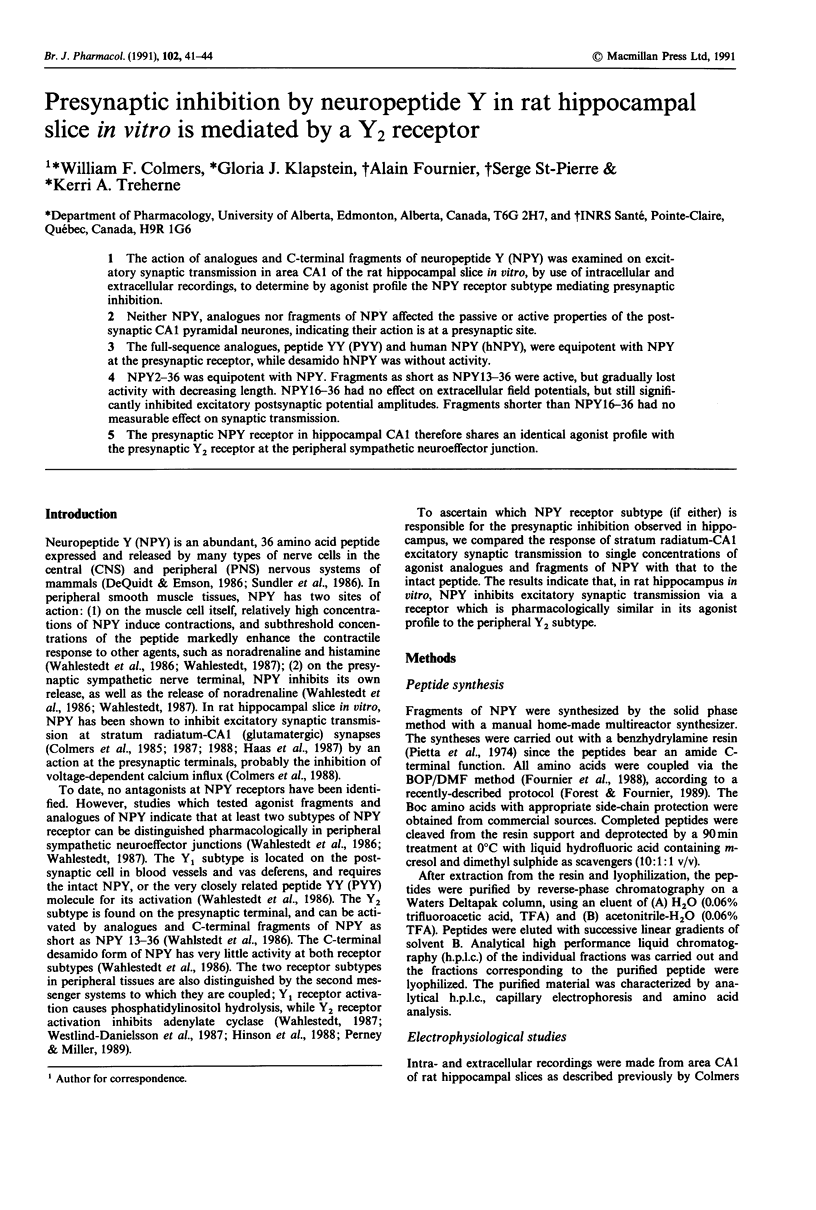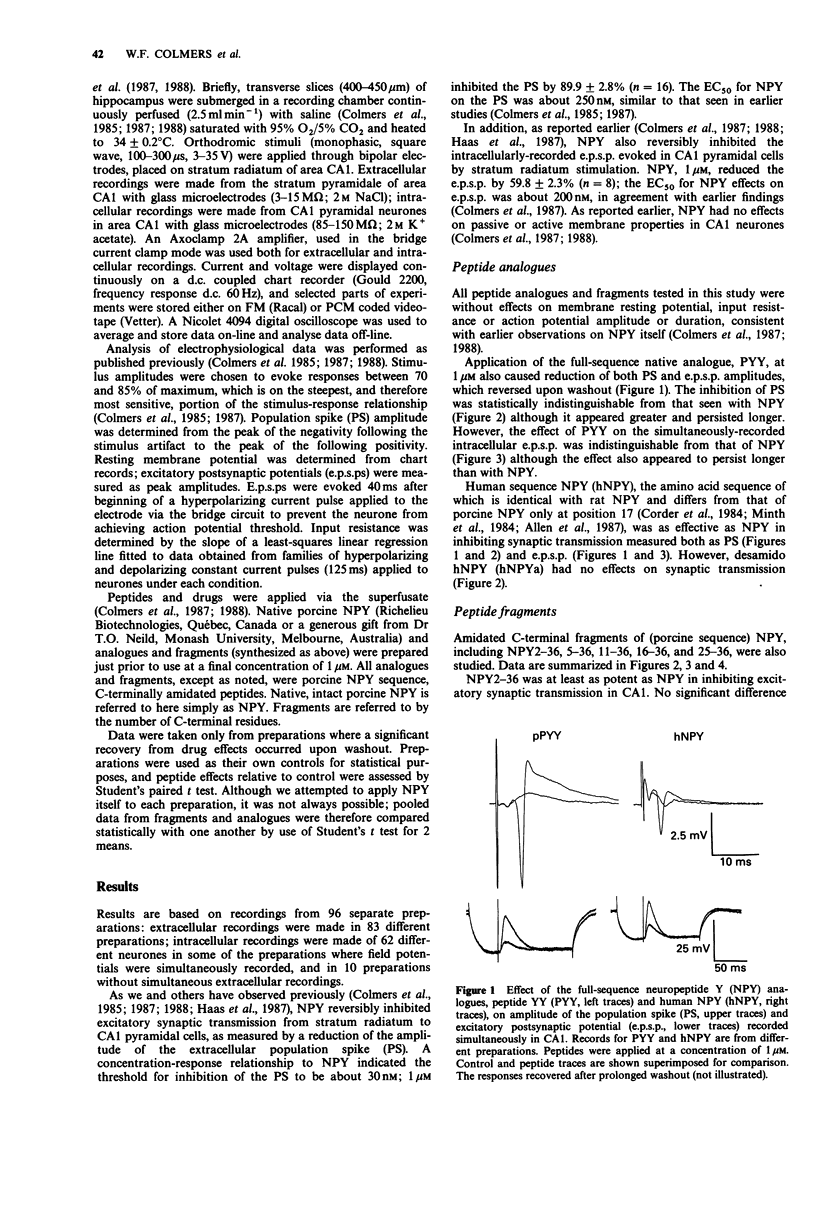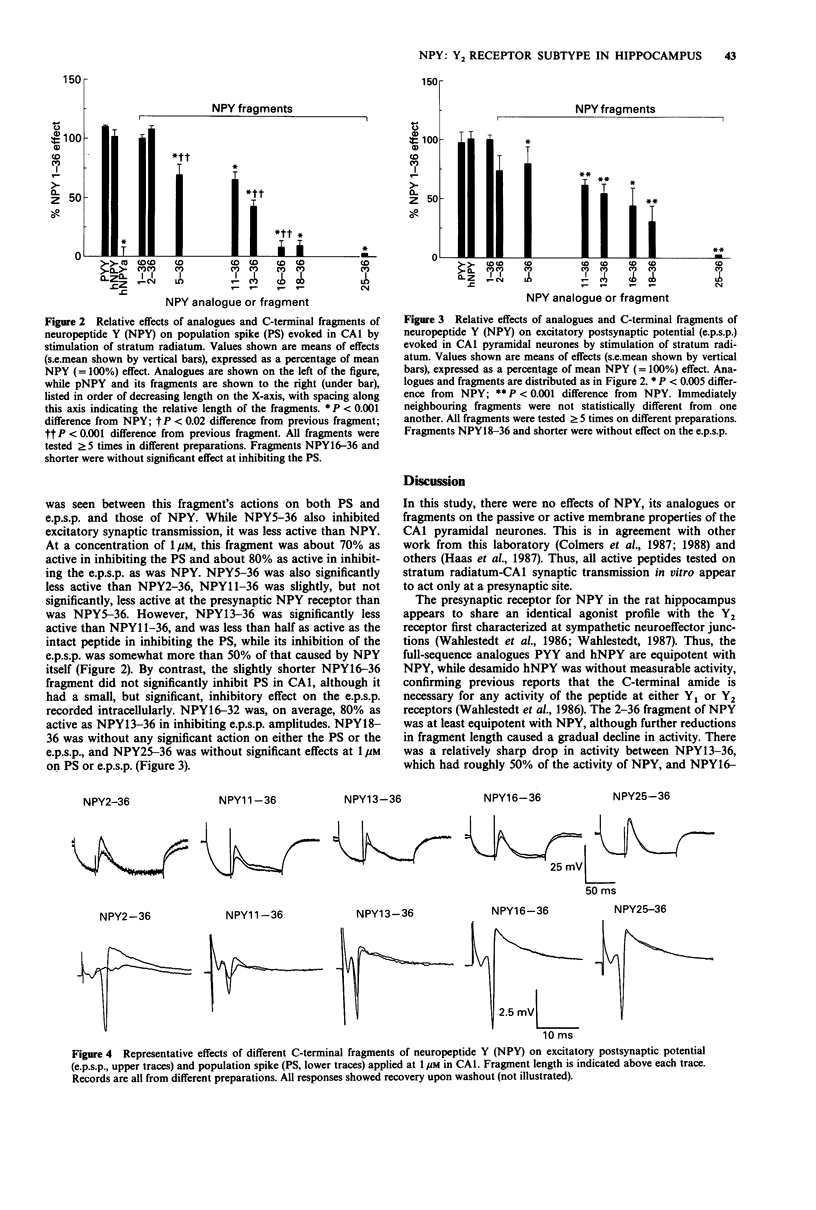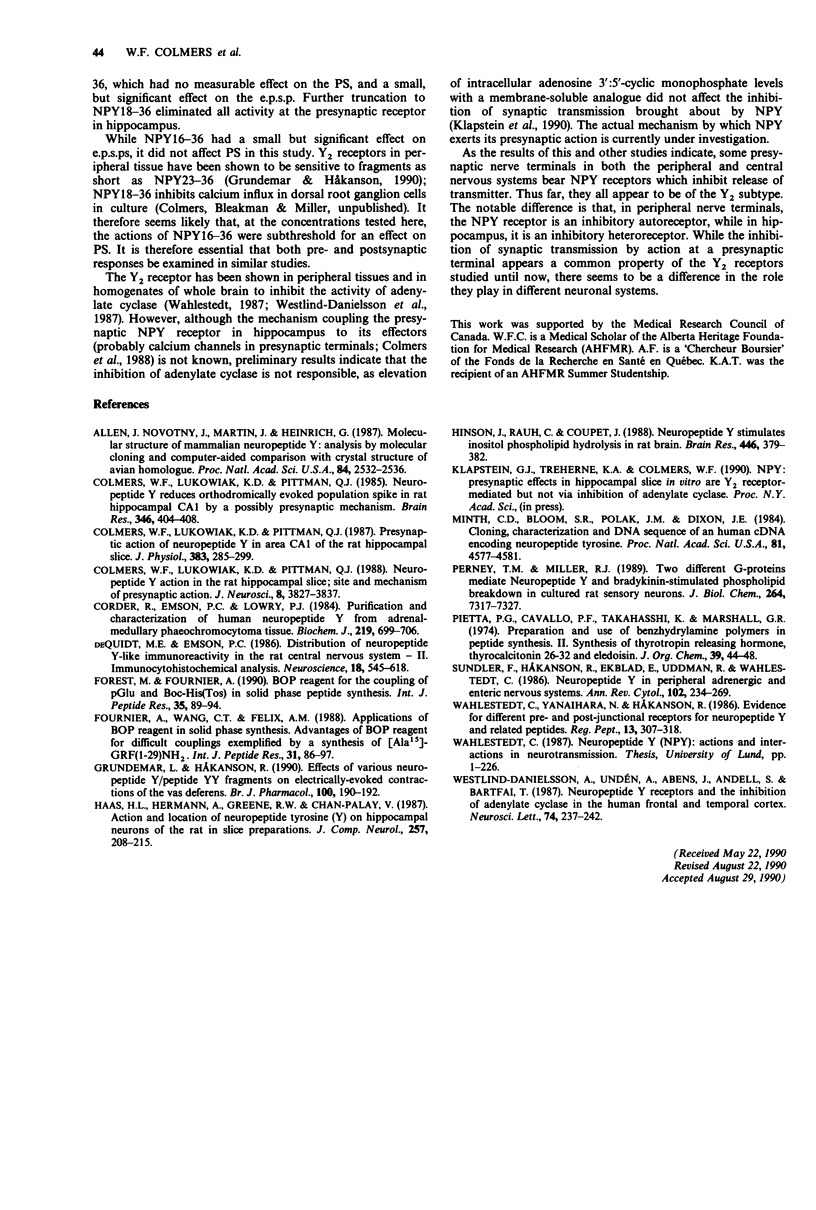Abstract
1. The action of analogues and C-terminal fragments of neuropeptide Y (NPY) was examined on excitatory synaptic transmission in area CA1 of the rat hippocampal slice in vitro, by use of intracellular and extracellular recordings, to determine by agonist profile the NPY receptor subtype mediating presynaptic inhibition. 2. Neither NPY, analogues nor fragments of NPY affected the passive or active properties of the post-synaptic CA1 pyramidal neurones, indicating their action is at a presynaptic site. 3. The full-sequence analogues, peptide YY (PYY) and human NPY (hNPY), were equipotent with NPY at the presynaptic receptor, while desamido hNPY was without activity. 4. NPY2-36 was equipotent with NPY. Fragments as short as NPY 13-36 were active, but gradually lost activity with decreasing length. NPY 16-36 had no effect on extracellular field potentials, but still significantly inhibited excitatory postsynaptic potential amplitudes. Fragments shorter than NPY 16-36 had no measurable effect on synaptic transmission. 5. The presynaptic NPY receptor in hippocampal CA1 therefore shares an identical agonist profile with the presynaptic Y2 receptor at the peripheral sympathetic neuroeffector junction.
Full text
PDF



Selected References
These references are in PubMed. This may not be the complete list of references from this article.
- Allen J., Novotný J., Martin J., Heinrich G. Molecular structure of mammalian neuropeptide Y: analysis by molecular cloning and computer-aided comparison with crystal structure of avian homologue. Proc Natl Acad Sci U S A. 1987 Apr;84(8):2532–2536. doi: 10.1073/pnas.84.8.2532. [DOI] [PMC free article] [PubMed] [Google Scholar]
- Colmers W. F., Lukowiak K., Pittman Q. J. Neuropeptide Y action in the rat hippocampal slice: site and mechanism of presynaptic inhibition. J Neurosci. 1988 Oct;8(10):3827–3837. doi: 10.1523/JNEUROSCI.08-10-03827.1988. [DOI] [PMC free article] [PubMed] [Google Scholar]
- Colmers W. F., Lukowiak K., Pittman Q. J. Neuropeptide Y reduces orthodromically evoked population spike in rat hippocampal CA1 by a possibly presynaptic mechanism. Brain Res. 1985 Nov 4;346(2):404–408. doi: 10.1016/0006-8993(85)90880-7. [DOI] [PubMed] [Google Scholar]
- Colmers W. F., Lukowiak K., Pittman Q. J. Presynaptic action of neuropeptide Y in area CA1 of the rat hippocampal slice. J Physiol. 1987 Feb;383:285–299. doi: 10.1113/jphysiol.1987.sp016409. [DOI] [PMC free article] [PubMed] [Google Scholar]
- Corder R., Emson P. C., Lowry P. J. Purification and characterization of human neuropeptide Y from adrenal-medullary phaeochromocytoma tissue. Biochem J. 1984 May 1;219(3):699–706. doi: 10.1042/bj2190699. [DOI] [PMC free article] [PubMed] [Google Scholar]
- Forest M., Fournier A. BOP reagent for the coupling of pGlu and Boc-His(Tos) in solid phase peptide synthesis. Int J Pept Protein Res. 1990 Feb;35(2):89–94. doi: 10.1111/j.1399-3011.1990.tb00240.x. [DOI] [PubMed] [Google Scholar]
- Fournier A., Wang C. T., Felix A. M. Applications of BOP reagent in solid phase synthesis. Advantages of BOP reagent for difficult couplings exemplified by a synthesis of [Ala 15]-GRF(1-29)-NH2. Int J Pept Protein Res. 1988 Jan;31(1):86–97. doi: 10.1111/j.1399-3011.1988.tb00010.x. [DOI] [PubMed] [Google Scholar]
- Grundemar L., Håkanson R. Effects of various neuropeptide Y/peptide YY fragments on electrically-evoked contractions of the rat vas deferens. Br J Pharmacol. 1990 May;100(1):190–192. doi: 10.1111/j.1476-5381.1990.tb12075.x. [DOI] [PMC free article] [PubMed] [Google Scholar]
- Haas H. L., Hermann A., Greene R. W., Chan-Palay V. Action and location of neuropeptide tyrosine (Y) on hippocampal neurons of the rat in slice preparations. J Comp Neurol. 1987 Mar 8;257(2):208–215. doi: 10.1002/cne.902570207. [DOI] [PubMed] [Google Scholar]
- Hinson J., Rauh C., Coupet J. Neuropeptide Y stimulates inositol phospholipid hydrolysis in rat brain miniprisms. Brain Res. 1988 Apr 19;446(2):379–382. doi: 10.1016/0006-8993(88)90898-0. [DOI] [PubMed] [Google Scholar]
- Minth C. D., Bloom S. R., Polak J. M., Dixon J. E. Cloning, characterization, and DNA sequence of a human cDNA encoding neuropeptide tyrosine. Proc Natl Acad Sci U S A. 1984 Jul;81(14):4577–4581. doi: 10.1073/pnas.81.14.4577. [DOI] [PMC free article] [PubMed] [Google Scholar]
- Perney T. M., Miller R. J. Two different G-proteins mediate neuropeptide Y and bradykinin-stimulated phospholipid breakdown in cultured rat sensory neurons. J Biol Chem. 1989 May 5;264(13):7317–7327. [PubMed] [Google Scholar]
- Pietta P. G., Cavallo P. F., Takahashi K., Marshall G. R. Preparation and use of benzhydrylamine polymers in peptide synthesis. II. Syntheses of thyrotropin releasing hormone, thyrocalcitonin 26-32, and eledoisin. J Org Chem. 1974 Jan 11;39(1):44–48. doi: 10.1021/jo00915a008. [DOI] [PubMed] [Google Scholar]
- Wahlestedt C., Yanaihara N., Håkanson R. Evidence for different pre-and post-junctional receptors for neuropeptide Y and related peptides. Regul Pept. 1986 Feb;13(3-4):307–318. doi: 10.1016/0167-0115(86)90048-0. [DOI] [PubMed] [Google Scholar]
- Westlind-Danielsson A., Undén A., Abens J., Andell S., Bartfai T. Neuropeptide Y receptors and the inhibition of adenylate cyclase in the human frontal and temporal cortex. Neurosci Lett. 1987 Feb 24;74(2):237–242. doi: 10.1016/0304-3940(87)90156-x. [DOI] [PubMed] [Google Scholar]
- de Quidt M. E., Emson P. C. Distribution of neuropeptide Y-like immunoreactivity in the rat central nervous system--II. Immunohistochemical analysis. Neuroscience. 1986 Jul;18(3):545–618. doi: 10.1016/0306-4522(86)90057-6. [DOI] [PubMed] [Google Scholar]


